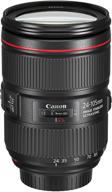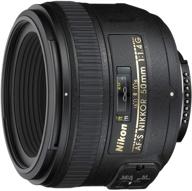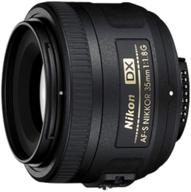
Review on Sigma 35mm F1.4 Art DG HSM Lens for 📷 Nikon - Black - 3.7 x 3.03 x 3.03 (Model 340306) by Ewa Jastrzbska ᠌

Its impossible to use it, dont waste your money.
I keep failing, and it seems as though the "algorithms" of the lens and the "algorithms" of the radio synchronizer are at odds with one another. There is absolutely no protection against dust and moisture, no rubber skirt at the foot of the mount, and absolutely nothing else. -the picture on the "open" begins to "soften" after being shot for an extended period of time in extreme frost. - The manufacturer offers a warranty of two years, which does not appear to be a coincidence. The "survivability" of Sigma lenses has traditionally ranked among the lowest of any lens brand. a lackluster quality control effort (and it's not just about alignment). For instance, if you go to eBay, you will easily be able to find many different deals, such as Nikon lenses that were first introduced more than 30 years ago. You won't discover much if anything if you look for Sigma lenses that were first made available at least twenty years ago. - In the year 2022, there exist service centers that are only semi-officially authorized to repair Sigma lenses; nevertheless, the repairs are laborious and take a very long time. Spare parts have a lengthy journey, and it is quite rare that the correct one can be located. - Bokeh. According to my nephew, who has eyesight of -5, "When I take off my glasses, the bokeh in my photos is even more amazing." In a review of the lens, if they state anything like "well, the bokeh of this lens is a matter of taste," it can only mean one thing: the bokeh produced by this lens is completely pointless. (50, 85, and 135mm - it is possible to say the same thing about these lenses)
- Everyone is aware of everything there is to know about the benefits of using this lens. Cutting. Because it is inexpensive (in comparison to autofocus branded full-frame rivals with an aperture of f1.4), it has quickly acquired appeal among expert amateurs who want a prime lens with a high aperture and a detailed picture. The popularity of this lens in synthetic tests was greatly aided by DXOmark. In addition, the front pages of the B&H website and many other locations were bought out for advertising banners. It turned out that sharpness was a highly sought-after item, and it was not difficult at all to make a sale of it. And I was one of those customers who bought it. Yet as time went on, I became aware of things that I would not have discovered in such a straightforward manner. I am going to come right out and say it: the lens was put up for sale as soon as possible once a sufficient number of "pitfalls" that were "crucial" for me had gathered. A total of four years was spent as the owner of that property.
- - The keenness. Yes. Do not wonder. I've included this quality under the 'dignity' and 'disadvantage' categories. Optics are an extremely delicate field of study. This is the part of physics where there are laws. When it comes to obeying these laws, compromises are unavoidable. In the beginning, I was satisfied with a picture that had a high level of detail and the capacity to inspect even the smallest of the image's details, but as it turned out later, it is not at all difficult to make merely a sharp lens with the computer power available today. This requires a forced measure such as an increase in the number of optical elements in the lens, because each optical element in the lens presents an unavoidable hurdle to the light that is allowed to go through the lens and into the viewfinder. The process known as "lens construction" can be challenging since it requires calculating the optical system in such a way that the sharpness can be maintained at an acceptable level while also ensuring that the images capture a lot of detail. As a matter of course, the volume in a photograph is achieved by utilizing techniques such as tonal gradation, aerial perspective, and the proper lighting of the subject that is being photographed; but, as it was discovered, there is also a technique known as. - Microcontrast. To be more specific, the total absence of it. The problem of making the lens resolve a multi-megapixel matrix and conveying the "volume" of the environment that is being photographed is a challenging one. When it comes to the lack of this flaw, Sigma lenses are the gold standard. This is one of the primary factors that contributes to the high cost of lenses from Zeiss, Voigtlander, and Lake. The calculation of the optical scheme must be done in such a way that the number of elements in IDEAL should not be greater than nine. The optical phenomenon known as microcontrast can be seen most clearly in black and white images. an especially illuminating photograph taken with a Voigtlander that can be found at http://www.mtyskfoto. Se/wp-content/uploads/2022/03/voigtlander-3. Jpg. - The autofocus feature does not operate effectively in conjunction with radio synchronizers since it causes a significant amount of frame jamming.
New products
Comments (0)
Top products in 👓 Lenses

Black Canon EF 24-105mm f/4L IS II USM Lens - Model 1380C002

78 Review

Canon EF 40mm f/2.8 STM Lens - Fixed Black (6310B002) for US Cameras

76 Review

📷 Nikon AF-S NIKKOR 50mm f/1.4G Lens with Auto Focus: Perfect for Nikon DSLR Cameras

76 Review

Nikon 35mm f/1.8G Auto Focus Lens for Nikon DSLR Cameras - Black (Model 2183)

125 Review







